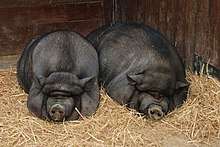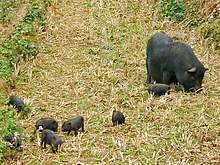Vietnamese Pot-bellied
Vietnamese Pot-bellied is the exonym for the Lon I (Vietnamese: Lợn Ỉ) or I pig,[lower-alpha 1] an endangered traditional Vietnamese breed of small domestic pig.
 In the Jardim Zoologico de Lisboa in Lisbon | |
| Conservation status | FAO (2007): endangered[1]:130 |
|---|---|
| Other names |
|
| Country of origin | Vietnam |
| Distribution | Red River Delta[2]:565 |
| Use | meat |
| Traits | |
| Weight | |
| Height | |
| Hair | black |
| |

The I is uniformly black and has short legs and a low-hanging belly, from which the name derives. The I is reared for meat. It is slow-growing, but the meat has good flavour.[4]:25 The I was depicted in the traditional Đông Hồ paintings of Bắc Ninh province as a symbol of happiness, satiety and wealth.[2]:616
History
The I is a traditional Vietnamese breed. It is thought to have originated in Nam Định province of Vietnam, in the Red River Delta. It was the dominant local pig breed in most provinces of the delta, and was widely distributed in Nam Định province and the neighbouring provinces of Hà Nam, Ninh Bình and Thái Bình, as well as in the province of Thanh Hóa immediately to the south, in the North Central Coast region.[3]
Until the 1970s the I was probably the most numerous pig breed in northern Vietnam, with numbers running into millions.[2]:616 From that time, the more productive Móng Cái began to supplant it. The National Institute of Animal Husbandry of Vietnam started a conservation programme, with subsidies for farmers who reared purebred stock, but this had little benefit – there was some increase in numbers, but at the cost of increased inbreeding.[2]:616 In 1991, the total population of the I was estimated at 675 000, and by 2010 the estimated number was 120. In 2003 the National Institute of Animal Husbandry listed its conservation status as "critical";[5]:76 in 2007 the FAO listed it as "endangered".[1]:130
Small numbers of I pigs were exported in the 1960s to Canada and Sweden, to be kept in zoos or to be used for laboratory experiments. Within a decade, the I had spread to animal parks in other countries in Europe; a few were reared on smallholdings. The I entered the United States from Canada in the mid-1980s, and by the end of the decade the "pot-bellied pig" was being marketed as a pet. Not all of these were purebred, and some grew to considerable size;[2]:616 the fad was short-lived.[6]
It was declared an invasive species in Spain: release of the Vietnamese pot-bellied into the wild, possession, transport and commerce of the breed are forbidden.[7]
Characteristics
The I is a small pig, with an average weight of approximately 50 kg, and an average height of about 36 cm. It is uniformly black, with heavily wrinkled skin. It has a pronounced sway back and a large sagging belly, which in pregnant sows may drag on the ground. The head is small, with an up-turned snout, small ears and eyes, and heavy sagging jowls.[2]:616
The I is robust and has good resistance to disease and to parasites. It is usually raised extensively, and forages well on the rice straw and water plants of its native area. It is particularly well adapted to the marshy and muddy terrain on which it usually lives: it has plantigrade feet, with weight borne on all four toes of each foot.[2]:616
Two principal types are recognised within the breed: the I-mo or Fatty I is the typical small short-legged pig, with small upward-pointing ears and a short snout; the I-pha or Large I is taller, has longer legs and a longer snout, with bigger ears held horizontally.[2]:616
Notes
- "Lon", Vietnamese: Lợn, means "pig".[3]
References
- Barbara Rischkowsky, D. Pilling (eds.) (2007). List of breeds documented in the Global Databank for Animal Genetic Resources, annex to The State of the World's Animal Genetic Resources for Food and Agriculture. Rome: Food and Agriculture Organization of the United Nations. ISBN 9789251057629. Accessed June 2017.
- Valerie Porter, Lawrence Alderson, Stephen J.G. Hall, D. Phillip Sponenberg (2016). Mason's World Encyclopedia of Livestock Breeds and Breeding (sixth edition). Wallingford: CABI. ISBN 9781780647944.
- Breed data sheet: Lon I/Viet Nam. Domestic Animal Diversity Information System of the Food and Agriculture Organization of the United Nations. Accessed June 2017.
- Huyen, Le Thi Thanh; Roessler, Regina; Lemke, Ute; Zárate, Anne Valle (2005). Impact of the use of exotic compared to local pig breeds on socio-economic development and biodiversity in Vietnam (PDF). Beuren, Stuttgart: University of Hohenheim, Institute of Animal Production in the Tropics and Subtropics; Verlag Ulrich E. Grauer;F. u. T. Müllerbader GmbH. ISBN 3-86186-496-7. Retrieved February 23, 2011.
- [National Institute of Animal Husbandry] (2003). The Vietnam National Country report on Animal Genetic Resources; annex to: Barbara Rischkowsky, D. Pilling (eds.) (2007). The State of the World's Animal Genetic Resources for Food and Agriculture. Rome: Food and Agriculture Organization of the United Nations. ISBN 9789251057629. Accessed June 2017.
- "The Joy of Pigs/ Pigs as Pets". PBS Nature. Accessed June 2017.
- "Real Decreto 630/2013, de 2 de agosto, por el que se regula el Catálogo español de especies exóticas invasoras". Boletín Oficial del Estado.
Further reading
- Nguyen, Thuy Thi Dieu (2004). Genetic diversity and distances of Vietnamese and European pig breeds analysed with microsatellite loci. Aachen: Shaker Verlag. Dissertation.